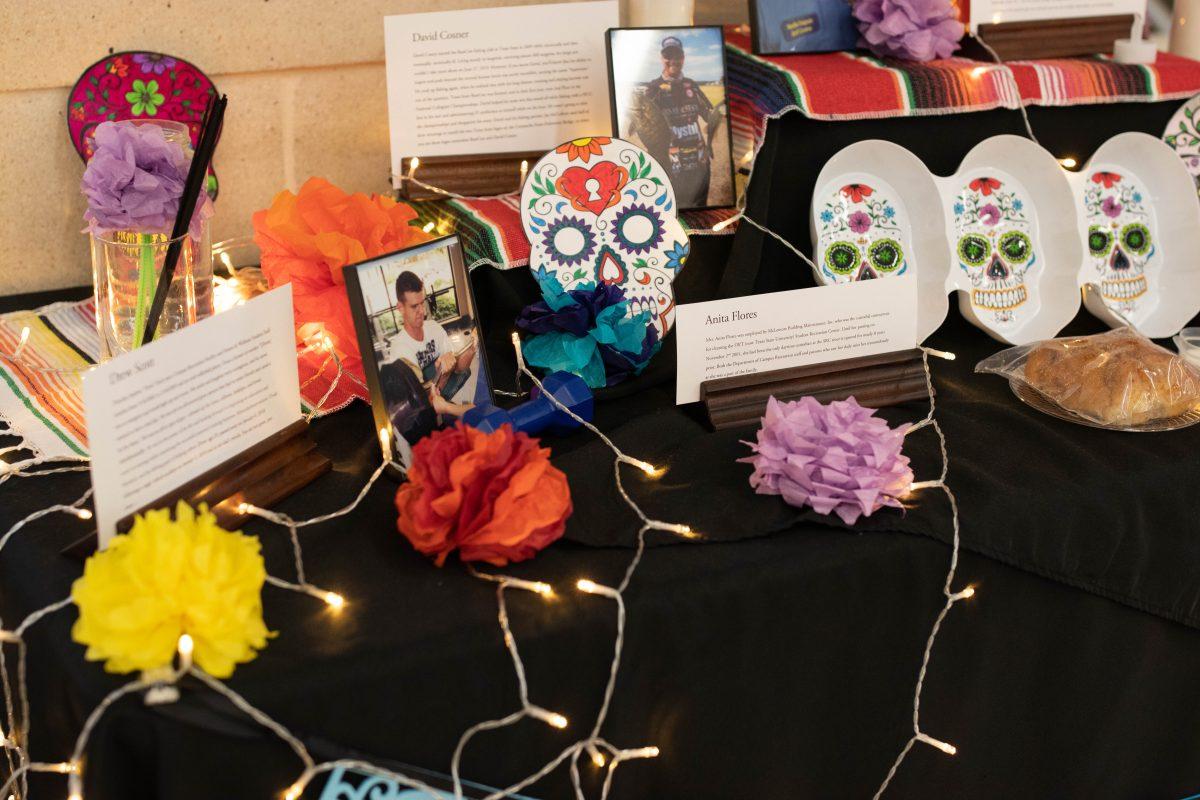Colorful flowers, intricate papel picado, sugar skulls and picture frames are taking up space on altars across the Texas State campus as offices celebrate Día de los Muertos to honor loved ones who have gone before them.
In years past, the number of ofrendas (altars) and Día de los Muertos celebrations on campus has been small. This year, there are 18 altars on campus, from the Student Recreation Center to the annual Honors College ofrenda in Lampasas Hall.
The tradition of setting up altars at Texas State began in the early 2000s when Michelle Sotolongo, Honors College advisor, and a friend set up an altar on campus as undergraduate students. Using their own decorations, they created a spot on campus to honor their loved ones and celebrate their Latinx heritage.
Now, with more celebrations and ofrendas popping up on campus each year, Sotolongo, who is also the coordinator of the Lampasas Hall ofrenda, said she is happy to continue creating welcoming spaces where the campus community is strengthened.
“There’s always new people; there’s freshmen, there’s new faculty and staff, there’s transfer students and so there’s always a new opportunity to expose somebody to something that they never heard about before,” Sotolongo said. “Especially being on a college campus … there’s a nice layer to all the opportunities of learning outside the classroom and interacting with things that you may not be familiar with. And, in turn, that can sometimes help students learn more about themselves or just spark some other kind of curiosity.”
Last year, the Honors College ofrenda was dedicated to Black and brown lives lost at the hands of police violence. This year, the altar honors Native children who were removed from their families and sent to residential schools and the Indigenous children whose remains were found at a school site in British Columbia, Canada, earlier this year.
By dedicating the altar each year, Sotolongo said she hopes to showcase the human and storytelling element of Día de los Muertos and share the stories of communities that are often overlooked.
“I think it’s a way of highlighting that we’re all tied together in different ways,” Sotolongo said. “There are a lot of communities that are not visible or they’re, you know, under-recognized. If there’s any way that we can contribute to highlighting their challenges and experiences and their needs, I know that we’re always looking for ways to do that.”
Taking a different approach to celebrating the holiday this year is the Office of Institutional Inclusive Excellence-Student Initiatives (IIE-SI) whose faculty and staff created a virtual ofrenda. The office invited students, faculty and staff to submit photos of their loved ones to be displayed in the virtual altar.
Sydney Rodriguez, a graduate assistant for IIE-SI, created a video of all the photo and name submissions for the IIE-SI website. She said she hopes the virtual format is something that happens every year so the ofrenda can be shared with anyone in the community.
“The whole objective that I personally have … is honoring those that loved us and honoring those who have made an impact or honoring those who just simply existed but [who] meant the world to us,” Rodriguez said. “I want to see that extended to all of Texas State and to the San Marcos community but also turn it into maybe even an opportunity where people can share stories.”
The goal of Día de los Muertos celebrations on campus is for Hispanic and Latinx students to feel a sense of belonging by seeing a beloved piece of their culture celebrated at school.
For Rodriguez, seeing ofrendas on campus and the initiative to create a virtual one shows the importance of making campus a safe space for students of all cultures.
“To tell you from a student lens, I feel like when students are in college, whether that be undergrad, doctoral or graduate, the focus has always been on academics, right?” Rodriguez said. “You’re trying to be this proactive, dedicated student and worker, but then you’re … not able to take as much time as you normally would to maybe celebrate these traditions and aspects of various cultures. And so, Texas State doing ofrendas … it’s more of just like, we all have our own backgrounds, and we all have people who have influenced us or have loved us. And it’s unfortunate they’re not here anymore but this is now an opportunity and a space to remember them and share that.”
Rodriguez said one of the best parts of seeing an ofrenda come together is that, despite not knowing anyone in the photos, each person featured has a story and each one had an impact on someone in some way. One of her goals for future ofrendas is to find a way to incorporate stories and personal anecdotes with the photos since storytelling is a big part of Día de los Muertos and Latinx culture.
Sylvia Gonzales, director for Project Maestros and HSI STEM Impact and vice president of the Hispanic Policy Network, said she is glad to see more celebrations on campus this year.
“We’re really trying to get participation from several departments on campus to join us in this and not just, you know, be one department or the departments that are affiliated with HSI [Hispanic Serving Institution] programming,” Gonzales said. “We want it to be everyone because we’re all HSI, not just the HSI department or the IIE offices … the entire university is considered an HSI and so we invite everybody across campus to join us in this celebration.”
Gonzales said it is important for all members of the community to join the celebration, especially since the experience of losing a loved one and conversations about death have loomed over everyone throughout the pandemic.
“You come to a point where you embrace that and you realize that, ‘hey, you know, there is no guarantee for any of us … life is short … there’s always gonna be those ups and downs in life,'” Gonzales said. “And it being okay that we acknowledge those people that came before us and celebrate the lives of our ancestors. It’s important to keep their spirits alive. I think this is important for me to see these altars on campus and to see so many people participating because of that personal connection to it.”
Gonzales said she hopes students who partake in this year’s Día de los Muertos celebrations can feel a sense of belonging and that those who may not celebrate gain a new appreciation for the holiday and culture behind it.
“[Ofrendas are] just kind of like a physical representation of [home]. There’s the food on there, there’s the flowers, there’s the picture to kind of remind you these are the people that really give you that sense of family and connection and community,” Gonzales said. “[What we hope to] accomplish is not only bring that awareness and opportunity to do that for those that celebrate this holiday, but also that those that don’t know about it, those that don’t celebrate it can understand the significance of those ties and connections that we do have to our familia.”
For more information on Día de los Muertos and to see a map of altars on campus, visit the HSI website.
Texas State celebrates loved ones, Latinx culture with Día de los Muertos
November 2, 2021
Donate to The University Star
Your donation will support the student journalists of Texas State University. Your contribution will allow us to purchase equipment and cover our annual website hosting costs.























